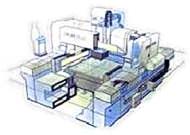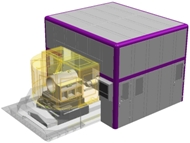 |
| Kodak OAGM 2500 - Off Axis Grinding Machine |
The Kodak OAGM 2500 Off Axis Grinding Machine is a classic example of a special purpose machine.
This machine was built in a specially made facility in the UK for proving and acceptance testing before being shipped to the USA.
 |
| Machine concept |
The initial concept of the OAGM 2500 machine shows how Cranfield Precision take a manufacturing problem, create a concept and a design and then turn it into a special purpose machine tool.
 |
| Machine Assembly |
Assembly of the large machine structure shows the symmetry and nature of the stiff repeatable structure.
Ensuring the surfaces are correctly formed and alignments are correct is a key part of the highly skilled assembly process.
 |
| Mirror Segment Inspection |
Technicians inspect the mirror segments that are manufactured in a controlled facility on the OAGM 2500 in Kodak's production facility.





